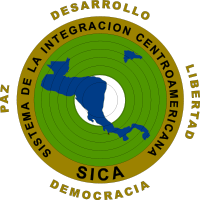Central American integration system
| Central American integration system SICA |
|
|---|---|
 Member States |
|
| Spanish | System of the Integración Centroamericana |
| Organization type | Regional political cooperation |
| Seat of the organs | San Salvador ( El Salvador ) |
| Secretary General | Juan Daniel Inglés |
| Parliamentary Assembly | Guatemala City |
| Member States | 8th |
| Official and working languages | |
| surface | 559,959 km² |
| population | 54 million (2014) |
| Population density | 97 inhabitants per km² |
| gross domestic product | 261 billion US $ (2013) |
| Gross domestic product per inhabitant | US $ 4,815 |
| founding | |
| Currencies |
|
| Time zone | UTC-6 to UTC-4 |
| Subsidiary organizations |
|
| http://www.sica.int | |
The Central American Integration System ( Spanish Sistema de la Integración Centroamericana , SICA ) is an intergovernmental organization of Central American states. It was founded on December 13, 1991 by Costa Rica, El Salvador, Guatemala, Honduras, Nicaragua and Panama through the signing of the Tegucigalpa Protocol and thus succeeded the Organization of the Central American States .
The system was developed taking into account previous experience for the association and the history of the region. On this basis, their primary objective was defined: the integration of Central America to create a region of peace, freedom, democracy and development based on respect, protection and human rights .
- Members
- Full members
- observer
At a summit in December 2008, the Central American states agreed on the introduction of a common currency, the introduction of a Central American passport and a 41-point economic plan to deal with the consequences of the global financial crisis . Among other things, a regional aid fund for the agricultural, service and trade sectors is to be set up. The summit participants also announced a standardization of laws in the areas of immigration, education and security.
Web links
Individual evidence
- ↑ [1] World Factbook, 2014
- ↑ List of countries according to gross domestic product
- ↑ [2] Latina-press.com
- ↑ Central American countries agree on a single currency. In: the standard. December 6, 2008, accessed September 4, 2011 .

